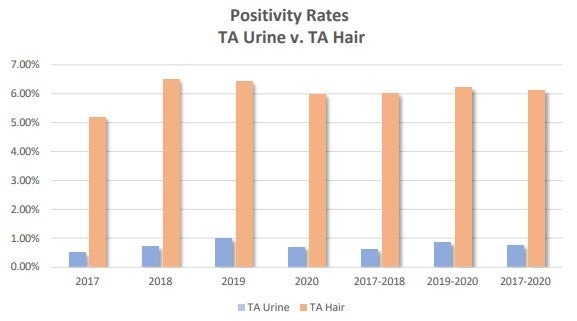A new study reveals that the U.S. Department of Transportation may be underreporting cocaine abuse by truck drivers, a finding that could put more pressure on federal regulators to allow hair testing as an alternative to urine testing for preemployment drug screening by trucking companies.
Because the Federal Motor Carrier Safety Administration’s Drug & Alcohol Clearinghouse does not allow hair test results to be included in the database, DOT “is seriously underreporting the actual use of harder drugs by truck drivers, such as cocaine and illegal opioids,” said Doug Voss, a professor of logistics and supply chain management at the University of Central Arkansas (UCA).
“Our analysis clearly concludes that hair testing identifies these harder drugs at higher percentages than the single urine testing method relied on by the federal government.”
Since FMCSA began publishing clearinghouse data in 2020, marijuana has far outranked other illegal drugs in positive test results, with cocaine and methamphetamines coming in a distant second and third, respectively.
However, 2020 data collected by UCA comparing preemployment urine and hair drug test results from major truckload carriers with urine tests in the federal clearinghouse found that an additional 58,910 drivers reporting into the federal clearinghouse would have failed preemployment drug tests had they submitted to hair testing.
The study found that cocaine and opioids were the most commonly identified substances in positive hair tests from the truckload carriers, with 16.2% more cocaine users and 14.34% more opioid users than were found in federal clearinghouse urine tests. “Utilizing statistical evidence, our analysis finds hair testing is more effective at detecting the use of harder drugs than urine testing,” the study noted.
The truckload carriers submitting data for the study — among them J.B. Hunt, Knight-Swift Transportation, US Xpress and Schneider National — are part of the Alliance for Driver Safety and Security, also known as the Trucking Alliance, which paid for the study. Trucking Alliance members all use hair testing as part of their own preemployment drug screening, even though the results are not legally permissible for use in the federal clearinghouse.
“Federal law prohibits truck drivers from using illegal drugs, yet thousands are escaping detection,” said Lane Kidd, managing director of the Trucking Alliance. “Drug-impaired truck drivers are a critical public safety issue, but employing these drivers can be a considerable liability risk.”
In September 2020 the U.S. Department of Health and Human Services released long-awaited proposed mandatory guidelines for the use of hair testing as an alternative to urine testing for preemployment and random testing of truck drivers.

(Source: UCA study, October 2021)
An HHS official stated in December that the agency is revising the proposal based on scientific data submitted during the proposal’s comment period. The final guidelines then must receive final departmental clearance followed by a review by the Office of Management and Budget.
Kidd asserted that until the federal government recognizes hair as a single test method, “employers should consider what Trucking Alliance carriers are doing and require driver applicants to pass the required urine test and also a hair test,” he said. “Driving a tractor trailer while under the influence is a lethal combination, and we must keep these drivers out of trucks until they complete rehabilitation and return to duty.”
Voss, who has conducted previous hair-test studies for the Trucking Alliance, told FreightWaves that he takes a “free-market view” on the issue.
“There are different carriers who have different risk profiles,” he said. “If you’re a larger carrier, I think you would be wise to use hair testing because you may not have the same ability to monitor your driver as closely as a smaller carrier. And smaller may not feel the need based on their risk factors. So there should be a choice — choose the testing methodology that best fits your risk profile.
As for the results of his study, “I think the safety implications are pretty straightforward,” he added. “You don’t want to have drivers on the road being allowed to drive a class 8 vehicle while using opioids and cocaine.”
FMCSA did not immediately respond when asked to comment on the study.










